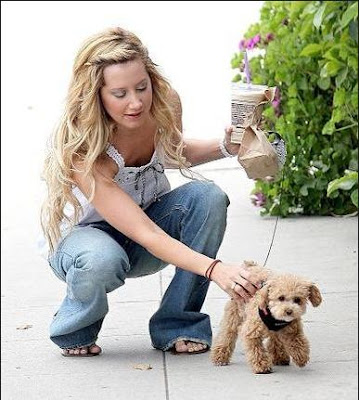
Helena Sung - Pet News Examiner
If you guessed the Chihuahua or Yorkshire terrier or even the poodle, you'd be warm.
 But in a highly unscientific study based purely upon empirical evidence (i.e., paparazzi photos), it appears that a certain "designer dog" has gained popularity among young Hollywood starlets.
But in a highly unscientific study based purely upon empirical evidence (i.e., paparazzi photos), it appears that a certain "designer dog" has gained popularity among young Hollywood starlets.The Maltipoo, a cross between a Maltese and toy or miniature sized poodle, seems to be the breed of choice among actresses, singers, and even an Olympic figure skater. Even Ellen Degeneres has one named "Wolf."








Kristina Murphy - Baltimore Pet Grooming Examiner
Does your cat need a bath?
 You might answer, “No, cats groom themselves”. And you might say this while Kitty prances around with matted gobs of litter hanging beneath his tail, hairs pointing in oily spikes, and flaky dandruff snowing onto the upholstery. Nobody blames you, who wants to bathe a cat? Who wants to handle a clawing raving acrobat? Yes, cats may groom themselves all day, but perhaps it’s a ploy, an illusion, to avoid the tub…
You might answer, “No, cats groom themselves”. And you might say this while Kitty prances around with matted gobs of litter hanging beneath his tail, hairs pointing in oily spikes, and flaky dandruff snowing onto the upholstery. Nobody blames you, who wants to bathe a cat? Who wants to handle a clawing raving acrobat? Yes, cats may groom themselves all day, but perhaps it’s a ploy, an illusion, to avoid the tub…You Know the Cat Needs a Bath When:
--You wonder if someone smeared vegetable oil through his fur
--Little white skin flakes fleck his coat (though this may require dietary changes)
--He rolled through a mud puddle and dried in the sun
--He danced with a skunk (might need a rabies booster, too)
--He found a secret crawl space in your home that hasn’t been cleaned since 1940
--His pantaloons encountered a bout with diarrhea
The time comes for every cat owner to give a cat a bath. Here are some suggestions for making the process painless as possible.
1. Clip the tips of the cat’s claws. You can use regular fingernail clippers for this. Only clip the very tip to remove the needle sharp point.
2. Thoroughly brush the coat and remove debris.
3. Snip away loose mats in the fur. If the mats are close to the skin, consider a professional grooming. Cats have paper-thin skin that easily tears, so practice caution with trimmers, scissors, and de-matting combs.
4. Leave the cat in another room while you fill a tub or sink with a few inches of warm water.
5. Keep all of your supplies handy- a cup, shampoo and towels.
6. Four hands are better than two are. If you have help, let someone hold the cat while you do the washing.
7. Wash the cat’s head and face with a wet washcloth.
8. Use a cup to scoop and pour water over the cat’s body.
9. Use a small amount of quality shampoo and rinse well. Soap residue causes irritation.
10. Towel him dry. You can try blowing him dry (if you’re feeling brave); otherwise, towel him well and let him scamper away to lick himself and pout for a few hours.
For oily fur, you can try a dry natural bath to avoid this process. Sprinkle cornstarch into the fur, brush it through, and brush it out.
Lindsay Barnett - LA Unleashed
Traveling with your dog? It can be fun, of course, and who doesn't love a good doggie nose print on the car window?
 It can also be dangerous, though -- a recent American Automobile Assn. survey reported that unrestrained pets cause more than 30,000 vehicle accidents every year. Our colleague Rosemary McClure at the Daily Travel & Deal Blog recently attended a pet travel seminar at Recreation Dog Park in Long Beach and offers these tips from dog trainer Sierra Smith:
It can also be dangerous, though -- a recent American Automobile Assn. survey reported that unrestrained pets cause more than 30,000 vehicle accidents every year. Our colleague Rosemary McClure at the Daily Travel & Deal Blog recently attended a pet travel seminar at Recreation Dog Park in Long Beach and offers these tips from dog trainer Sierra Smith:Her top recommendation: Crate your dog while it’s in the car. Other tips include never letting pets ride in the front seat, confining them to the back hatch area (if it's roomy enough), using harness restraints that clip to the back seat belt or a back seat zip line (optional equipment in some vehicles [including the new Venza]).
Also always make sure your dog's ID is up to date and lists your phone number and bring along a copy of your dog's vet records when you travel.
If you use a correction collar on your dog, never leave it on while in the car. And remember to give your dog breaks every two or three hours while traveling and never leave your pet in the car on a hot day.
Once you get to your destination, you'll need a place to stay and things to do, and several websites offer listings of pet-friendly accommodations and attractions. A few are BringFido, PetTravel and DogFriendly. Happy trails!

Jane Porricelli - Providence Dogs Examiner
Pet owners have always been fans of filming their furry friends' silly antics (ever seen an episode of America's Funniest Videos?). But with video-sharing sites like YouTube becoming increasingly popular, it's no wonder that some pet videos are becoming big Internet sensations.
The most recent is the video of Bizkit the Sleep Walking Dog. People logging on to see Bizkit take the term "doggy dream" to the extreme has yielded nearly 2.5 million hits for the video, which can be seen here on YouTube.
But there are many other amazing pet videos out there, like the one of Sweet Pea the Jump Roping Dog, who, according to the Guinness Book of World Records, holds the record for the Most Jump Rope Skips by a Dog in One Minute. Here is a YouTube video of her appearance of Oprah, where she also - get this - walks up a staircase balancing a glass of water on her head.
And then there's Maggie the Counting Dog, who knows how to add, subtract - and even multiply. She taps her paw a certain number of times to indicate the answer to the mathematical equation asked of her. The YouTube video of her performing on Animal Planet's Pet Star can be seen here.
What are some of your favorite pet videos?



By Steven W. Barnes - Hearst Newspapers
PRINCETON, N.J. — After winning a Golden Globe award for best actor in the film "The Wrestler" last month, Mickey Rourke surprised many with his acceptance speech, thanking the dogs in his life, "the ones that are here, the ones that aren't here anymore," Rourke said, "because sometimes when a man's alone that's all you got is your dog."
Many Americans, myself included, would agree with Rourke. According to the 2007-2008 National Pet Owners Survey commissioned by the American Pet Product's Manufacturer's Association, 63 percent of U.S. households own a pet — approximately 71.1 million homes. But today many companion animals, like their owners, are impacted by the economic crisis. This month the American Society for the Prevention of Cruelty to Animals (ASPCA) estimated that between 500,000 and 1 million cats and dogs in the U.S. are at risk of becoming homeless as a result of the continuing downturn, in spite of efforts by non-profits and charities to keep pets and pet owners together. Add that to numbers from the non-profit Humane Society of the United States (HSUS), which estimates that each year between seven to eight million cats and dogs enter America's animal shelters, and approximately three to four million are euthanized annually.
But Americans will do a lot to keep their pets in times of hardship. For example, the Providence Journal reported this month that local Meals on Wheels services are distributing donated pet food with human meals, because of the "agency's concern that some of its clients were sharing their meals with their beloved pets, short-changing their own nutritional needs," the newspaper reported. "Most of our clients are 85 (years old) and up," explained Meals on Wheels of RI president Sandy Centazzo, "and in many cases the only thing they might have is a pet, which is everything to them."
In this light, HSUS now features on its website a section titled "Having Trouble Affording Your Pet?", which provides a state-by-state listing of organizations that may provide financial aid or other assistance, like pet food or temporary foster care, to pet owners "who are facing financial difficulties due to the current economic situation." The ASPCA's website also offers tips to pet owners in dire economic straits — from seeking a temporary home for a pet with friends or family, to advice for surrendering a pet to a credible shelter with the animal's proper medical and behavioral information ''and anything else that might help the pet find a new home."
For those who seek to help pets and pet owners in need, groups like the ASPCA offer the following advice: donate used blankets or towels to a local animal shelter, if possible help community members who may be struggling to take care of their pets and consider adopting a pet from a shelter. On a personal level, I can attest to the value of pet adoption. I first met our dog Midnight in 1995 — he was a shelter animal, given up by a family when he was nine months old. A shelter staffer had written on Midnight's paperwork, ''A good little guy!"
Was that person ever right, as Midnight demonstrated for the next 14 years. A 12-pound mutt, Midnight was small, mostly black (hence his name), with some white hair around his chin — white that would spread as he aged over his muzzle and around his eyes like a mask — and white on his chest and paws. He was a lapdog, mellow and very social.
Pet adoption should not be pursued cavalierly, as pet ownership entails significant responsibilities — including understanding what kind of pet a household can reasonably handle, awareness of local licensing and vaccination laws, the value of spaying and neutering, and knowing how to provide a pet proper shelter and companionship. Costs for things like nutritious dog food, pet supplies, and veterinary care quickly add up. As Midnight got older and required more vet visits, my wife and I would joke that our veterinarian drove around in a solid gold car, paid for by us. Our social calendar was permanently altered to make sure we were available to walk and feed him, as well as the two other dogs we have.
And in the end, sometimes pet ownership requires the toughest responsibility of all. Earlier this month, Midnight's breathing became noticeably labored, and he was soon diagnosed with a rapidly spreading cancer in his lungs. We were stunned to learn he had, at most, weeks to live. Ten days after the diagnosis, he reached a point where he was fighting for every breath. And so Midnight died at our local vet clinic, his head resting on my hand and his eyes half-closed, vaguely looking at me just before he passed away.
Steven W. Barnes is an assistant dean of public affairs at Princeton University's Woodrow Wilson School:sbarnes@princeton.edu

Sharon Seltzer - Pet Rescue Examiner
 Raids on puppy mills are in the news a lot lately. The stories talk about hundreds of dogs being rescued and taken to animal welfare groups for safety. But do you know what happens after that? Here is one dog’s personal story that was reported by Amy Carter who writes for Examiner.com as the Minneapolis Nightlife Examiner.
Raids on puppy mills are in the news a lot lately. The stories talk about hundreds of dogs being rescued and taken to animal welfare groups for safety. But do you know what happens after that? Here is one dog’s personal story that was reported by Amy Carter who writes for Examiner.com as the Minneapolis Nightlife Examiner.Eva lived the first five years of her life in a small cement cell giving her owner one litter of puppies after another. In five years she never saw daylight, never chased a ball and never interacted with people. Then in January, the breeder didn’t want her anymore.
That’s when Minnesota Boxer Rescue stepped in and saved Eva’s life. She would have been euthanized by her owner. The non-profit group rescues unwanted Boxers, rehabilitates them with foster families and finds them new homes.
Jodi Black, Vice President of the organization said, “When Eva first came to us, she was scared. She didn’t know how to walk on a leash and all she did was crouch to the ground. We had to carry her to and from the car. She didn’t want to be around humans.” “It was heartbreaking.”
Then Jodi introduced Eva to her three dogs and slowly the pup came out of her shell and started to do the happy “Boxer wiggle.” She learned to play with toys, use a doggie door, and saw that “humans can provide more than just food to her.”
On February 20th Eva was ready to be spayed. This was the next step in helping her find a new home. But the simple surgery didn’t go well because of the many litters of puppies Eva had in the past. She began to bleed badly and was rushed to an emergency clinic where they pumped out the blood from her abdomen.
Then Eva’s blood pressure dropped and the bleeding started up again so she was transferred to the University of Minnesota for intensive care. The dog was so weak when she arrived that it took two blood transfusions before they could do an exploratory surgery to stop the bleeding. It took 21 hours before Jodi learned that Eva was stable and that a small tear had caused her problems.
Eva is on bed rest and getting stronger everyday. She is expected to make a full recovery. But in saving her life, the volunteers from Minnesota Boxer Rescue incurred more than $6,000 in veterinary bills.
“Our rescue is non-profit and run by a group of volunteers who foster out of our homes,” said Black. We need your help to raise money to cover Eva’s emergency so we can continue to take-in Boxers that are surrendered or saved from death in shelters.”
Jodi says that Eva will be ready to find a new home in a couple of months. She is looking forward to the day when the frightened Boxer can live like the “princess” she was meant to be. You can read Eva’s complete story and learn how to make a donation at Minnesota Boxer Rescue.

Sandy Weaver Carman - Atlanta Dogs Examiner
Dog-lovers know...dogs want to be part of a team with their owners. It's in their DNA to work with humans, so if you take what your dog's genes tell him to do - fetch, herd, pull, etc. - and harness it into a game the two of you can play, you've just made team-building exercises for you and your dog. Some people take team-building with their dogs to the extreme and enter competitions, and this weekend features a big competition, a smaller, local one, and a way to enjoy your dog years after he's gone from your life.
Last weekend, the Junior Iditarod was run, and Cain Carter, son of Lance Mackey and at 17 a three-time veteran of the Junior Iditarod, bested the field of 23 young mushers. He ran his 160 miles, with a mandatory 10-hour layover, following much the same rules that his Dad Lance will as he runs his 1150 or so, starting today. There are 68 teams poised to run the last great race on earth, with another dozen that have scratched. A dozen of the mushers who will start today are women, and 15 mushers are Iditarod rookies, though not racing rookies…they have to have a good racing track record to even enter the Iditarod.
The weather in Anchorage today is blue-sky beautiful, but a bit warm for the dogs at 24 degrees. Today’s start is the ceremonial one – they’ll stop after a short run and will re-start in Willow, AK at 2pm tomorrow. Today, Willow is cloud-covered with light snow falling, though it’s expected to be in the mid-20’s there, too.
This year, the Iditarod Trail Committee has made it easy to follow the entire race, albeit for a price. Follow the mushers’ GPS trackers and know the speed and relative positions of each time and where they are in the wilds of Alaska at all times. There’s also video reports, musher interviews and more on the Insider video channel.
Want to watch some amazing canines a little closer to home? Check out the agility trials at Wills Park Equestrian Center in Alpharetta. Complete details on what you’ll see are here.
How do dogs become great team-mates? With a little training, of course! Gwinnett Humane Society is offering good-manners classes beginning March 15 so you and your dog can learn some team-building skills. The price is right…$75 for the series of classes, $65 if your dog was adopted through a rescue or humane society, and only $50 if your dog was adopted through GHS. Pull out your paperwork from the adoption, because you will have to provide proof of adoption. Classes are for registered participants only, so you’d better get registered this weekend.
From 9:30 this morning til 2:30 this afternoon, learn to draw a lifelike portrait of your dog in pastels. You don’t have to be an artist, just someone who loves art and your dog. Take along several good pictures of your furry friend that show good facial details. This is a class for ages 12 and up, and is being held at the Spruill Center for the Arts on Chamblee Dunwoody Rd. The fee is $85. To see if there’s space left or to find out when the next puppy-pastel class is, call 770-394-3447.

Inside Stoop About Golden Retriever Dogs
by Dana Morse
Golden retrievers are one of the most well liked breeds of dogs today.
But what do you know about this dog? The Golden Retriever was developed in the 1800's in the UK. The breeder, Lord Tweedmouth, wanted a dog that was devoted, kind, enthusiastic, and energetic. He also has a desire for a dog that enjoys water and prides himself in the power to retrieve. Golden Retrievers are the embodiment of beauty and brains.
Specified as a sporting dog, the standard Golden Retriever male weighs between 65-75 lbs. And the female smaller at 55-65 lbs. A adult Golden retriever dog stands about 23 to 24 inches in the female of the brief span about 21.5-22.5 inches. Goldens' coats are assorted shades of gold. The firm, resilient outer coat will be straight and wavy.
The tail and legs are feathered with longer hair whilst the under coat is dense and soft in texture.
The coat color varies in shades of cream to gold and is rich and lustrous. The Golden is a heavy shedder. The Golden Retriever is a giant, and energetic reproduce making them the planet's foremost family pet and companion. the Golden retriever dog has a sharp mind and is a flexible breed that will learn quickly. They are sweet, ardent to delight, and devoted family companions who are always peaceful and patient with kids.
They exude charm and confidence however they don't do well if left alone for extended periods and may become mischievous and destructive. Their dogs with great excitement and thrill in their personality. They get along with other pets. In reality, they will be nice to everybody. They have a tendency to bark as a type of greeting. The Golden Retriever isn't well suited for a 2 career family as they need an inordinate amount of human interaction and friendship. they are great with obedience and serve as a great care dog. Also, they are susceptible to hip dysplasia, cataracts, and skin allergies so regular veternarian check-ups are necessary.
Golden's will do okay in an house dwelling provided they're satisfactorily exercised. The Golden Retriever needs daily exercise and they enjoy play sessions with their family, retrieving balls and other toys. Golden Retriever puppies should be acquired from credible Golden Retriever breeders who should be in a position to provide paperwork from the Yank Dog house Club or similar registry organization.
Ideally, you should be in a position to view the folks. An alternative to buying a puppy is to take on a Golden Retriever from a Golden Retriever rescue or other rescue organization like the Humane Society. Mow you may be thinking, you know all that there is to know about Golden retriever dogs. Remember that like any pet, owning a Golden Retriever is a long term, heavy commitment.
About the Author
Dana Morse writes regularly about entertainment related topics. I hope you enjoy this article.
Can You Train a Cat?
By Troy Foote
Cats are wondrous, wonderful creatures, and are filled with curiosity. They can be snuggly, affectionate and friendly creatures; often content to nap on a human lap and be stroked until their fur glistens. Some are more standoffish and will only allow the occasional solemn head pat before regally stalking off to stretch and preen in the sunshine. And others are just way out there wild cats, hell bent on running straight up the walls in pursuit of invisible prey, knocking down all who dare get in their pathway. While you cannot change the basic nature of the cat that you have in your home, you may wonder just how can I train this energetic ball of fur? How you can change some of his more obnoxious behavior? Just how can you train a cat?
Your first cat-training tip should be to understand why they do some of the things that they do. Some cat behavior is out of boredom, some out of transitional changes as they grow out of kitten stages into adulthood, and some can be a symptom of impending or ongoing illnesses. Knowing which is which can help you to avoid potentially dangerous problems before they become life threatening.
Once you have a basic understanding of how to train cats and the why`s of cat behavior, you can start working on the things that he will need to change.You are on your way to learning how to train cats. Make sure that you have a list of the poor behavior, and start with the worst offender first. Try to teach new behaviors one at a time, because too many changes will make the cat confused and potentially worst behaved than before. If a cat is doing something that is possibly dangerous that problem should be addressed first, otherwise, it is at your own discretion.
Remember that learning how to train cats is a matter of patience triumphing over frustration. Shouting at a cat does not work at all, and in fact will bring up a whole new set of issues. Timid cats will become even more fearful, and aggressive cats may take your shouting as an actual threat, so remember that a startled cat will not always react with James Bond coolness- sometimes they bite.
Do not bother with reprimanding your cat, as it is often an ineffective maneuver as well. Cats will learn that getting caught doing the targeted behavior brings about some horrible reactions, so they will simply learn to hide better. This is seen frequently with toileting issues. A cat will stop using his litter box for a variety of reasons, including illness, so that you must find out why. Finding kitty messes after the fact is a pain, but it will not do you any good to drag the offending furball over to the spot, show it to him and then take him to the litter box. Unless he is a brand new cat or you have moved homes recently, he knows full well where that litter box was, he just did not use it. Find out why and the behavior should be stopped. Eliminate all causes, including sickness, and then work from there. Some cats will never use a litter box, but will allow themselves to be trained to use an alternative. Bizet, the big fluffy cat is too big for the litter box, but he does scratch at the door when he needs to go. He is a psycho the majority of the time, but for this one, he deserves a good kitty!
Advantages of Learning how to train cats
Despite all of the stereotypes, kitties are not completely self-sufficient creatures. They still need their human families to feed and water them, and to protect them from the elements. And, despite all of their protests against it, kitties need their humans to love them. Adopting a cat can be a very rewarding feeling, as well as a major challenge at times. We want our family life to be calm and warm, not frantic and frustrating, so we need all of the members, including the furry ones, to be at their best behavior. Learning how to train cats can ensure that you have a gentle, loving pet that does not eat your furniture and pee in your houseplants. Training your cat does not only protect it from potential dangers, but keeps your belongings safe from destruction as well.
Cats claw, scratch, bite and chew for many reasons. If they are doing these things to food items or their cat toys, that is great, but many times they will find something else. Cats that chew on the new divan or the electrical cords are not only destroying property, they are also potentially put their own lives in danger. Young cats will mouth or chew on things for the same reasons that puppies and human babies do- they are exploring their world, as well as teething. Give them substitutes and reward them for chewing on the right items. If an older cat has suddenly developed a urge to gnaw on things other than food or usual toys, then consider whether he is bored, or if it is possible that he has a nutritional deficiency.
Poorly trained kitties will often start using the entire house as their personal litter box. If you have ever walked in the house when the litter box needs to be changed, you know how disgusting that can truly be. If your cat is using items like your bed or favorite chair to potty on, he might be sending you a message. Does he loathe the new litter you bought? Did you move his litter box? Or, have you started spending too much time with that guy in 2A that stomps his feet at kitty when you are not in the room? Although most cats will train well to the box and never have issues, some are more stubborn and this behavior can often be the deal breaker for many families.
A well-trained cat will charm and amuse your guests when they come to your home. He will make your days seem warmer and brighter. Because he knows what is expected of him, he will not have as much anxiety, leading to a calmer more easily controlled cat. Calmer cats are more affectionate because they are not nervous or high-strung. Training your cat allows him to focus on good behaviors and the things that make a cat's life a good one; napping, eating and stalking dust motes in the sunny patch by the window.
Written by Troy Foote. Pet advocate and owner of Pamper Pet Care. Your online resource for pet health care and nutrition.
For other pet health articles and to download the free Pet Food Secrets Report please visit us today.
Article Source: http://EzineArticles.com/?expert=Troy_Foote










No comments:
Post a Comment